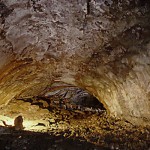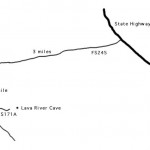 Hidden in the forests near Flagstaff is a bit of a surprise. As you walk among the pine trees you suddenly come to a hole in the ground, a low stone wall your only clue that something is there. For the scattered pines and wide meadows that surround you give no hint of what lies below. But here fire once ruled and lava flowed across the landscape that is so peaceful now. One such lava flow has left a unique feature, a lava tube. Here is where the lava continued to flow inside a lava flow that was cooling from the outside in. Here, insulated inside the body of the flow the lava remained liquid and flowed further down the slope to emerge at the forward end of the lava flow. But when the eruptions came to an end and less and less lava was emerging from the volcano the tube started to empty. Eventually the eruptions stopped altogether and what lava remained in the passage cooled where it sat. This left a roughly circular passage half filled with solid lava. Now, millennia later, this passage remains. The fire of the earth is gone, and we can explore.
Hidden in the forests near Flagstaff is a bit of a surprise. As you walk among the pine trees you suddenly come to a hole in the ground, a low stone wall your only clue that something is there. For the scattered pines and wide meadows that surround you give no hint of what lies below. But here fire once ruled and lava flowed across the landscape that is so peaceful now. One such lava flow has left a unique feature, a lava tube. Here is where the lava continued to flow inside a lava flow that was cooling from the outside in. Here, insulated inside the body of the flow the lava remained liquid and flowed further down the slope to emerge at the forward end of the lava flow. But when the eruptions came to an end and less and less lava was emerging from the volcano the tube started to empty. Eventually the eruptions stopped altogether and what lava remained in the passage cooled where it sat. This left a roughly circular passage half filled with solid lava. Now, millennia later, this passage remains. The fire of the earth is gone, and we can explore.
Lava River Cave (also called Government Cave) is located on National Forest land and is open to the public with no pre-arrangement except your ability to get there and into the rugged entrance. The entrance is a collapsed section of the roof of the lava tube, here you have to scramble down into the earth. Don’t despair as you enter the cave, it get easier after a hundred yards or so of boulders.
It is my opinion, backed up by a few observations, that most of the collapsed rock about you fell during the eruptions or shortly thereafter while the tube was still young. Looking at the sheer size of the collapsed boulders does give one pause. What if a few more fell while we were here? How dangerous is this place? Probably not very, The entrance probably collapsed during the eruptions or shortly thereafter. The huge number of rocks you must cross near the entrance is dramatically different than the clear floor through much of the passage.
After a few hundred feet of loose boulders the floor changes. Here the lava sits where it cooled, forming a level but very rough surface. Looking much like asphalt that the paving crew neglected to run a roller over to smooth out. This is the surface you will be walking on most of the way

Cave Interior
About half way along you face a decision, the passage divides left and right. The way you take doesn’t really matter, the passages join up again a little further on. But the passage to the right is more appropriate to dwarves. There is little sign when you look at the two openings, but the right passage ceiling lowers to about three feet from the floor. Not easy to pass, as the very rough floor keeps you from crawling on hands and knees.
Then look about at the cave today, the ceiling is smooth where rock must have fallen free, but there is no rubble below where it fell. A puzzle! But what if the lava was still molten and flowing, and carried away the debris? If you look around there are still plates of smooth rock embedded in the top of the flow. You can actually see where these plates fell and the still soft lava began to ooze around it as it sank into the soft surface.
Another feature is what I have called gutters (I’m sure vulcanologists have another term). It looks like the lava in the tube formed a crust along the edges, but then as the level of lava in the tube fell it left behind this crust looking like a gutter along the wall of the cave.
It is important to remember that everything here was created by fire. If you remember that lava flowed through this channel and eventually cooled and slowed. it explains what you see around you. Imagine this channel of lava still flowing, but freshly formed, still unstable, plates of rock falling from the ceiling into the lava below. Keep in mind these conditions when you look at any feature of the cave and a little logic will explain what you see.
Eventually you come to the upper end of the cave, where the ceiling takes a sudden dive into the floor, beyond here the tube is completely filled with rock and we can go no further. There may be more to the tube further uphill but it is beyond our reach and we must turn around and return the way we came to once again reach the bright Arizona sunlight.
When You Go..
Lava River Cave presents no major difficulty and is suitable for anyone who wishes a different sort of adventure. You don’t have to be a spelunker to venture into this cave.

Another requirement for this cave is rugged boots and clothing, the floor is quite rough. Hiking boots recommended or maybe an old pair of sneakers that you don’t mind getting ripped up. Even your boots will show a new gouge or two after this hike.
The one remaining difficulty is in finding the place, the turnoff from the highway is not signed, probably a good idea since this is not a good place to show to all of the day tourists headed to the Grand Canyon from Flagstaff. Once off the highway the roads are dirt and passable in any vehicle. When it rains however the road can get quite muddy and it would probably be best to avoid without a high ground clearance or four wheel drive vehicle.
You will need the map. Use your odometer to find Forest Service road #245. After leaving the state highway there is a three mile drive through pine woods and meadows to a T intersection. Turn left and proceed another mile to another left turn for the cave. As of June 1998 there is no sign for the cave at the highway but the next two turns are signed. There are several other roads, look for the small sign or post just inside the turn with some numbers. When you arrive at the cave there is a fence and post barrier that stops you a few hundred feet from the cave just find a place to park and walk the last bit.

